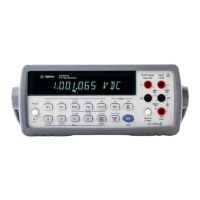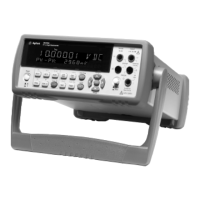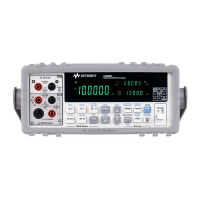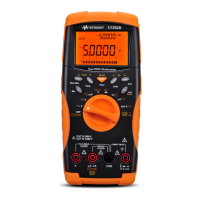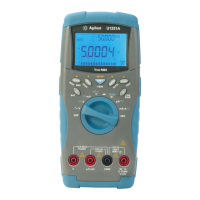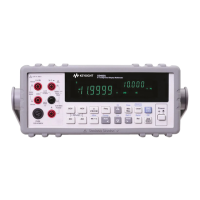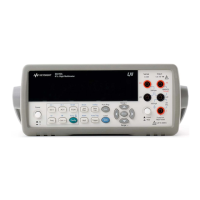Chapter 4 Making Measurements 97
in memory.
10 OUTPUT 722;"TARM HOLD" !SUSPEND READINGS
20 OUTPUT 722."DCV 1" !DC VOLTAGE, 1V RANGE
30 OUTPUT 722;"MEM FIFO" !ENABLE READING MEMORY, FIFO MODE
40 OUTPUT 722;"TRIG AUTO" !AUTO TRIGGER EVENT
50 OUTPUT 722;"NRDGS 10,AUTO" !10 READINGS/TRIGGER, AUTO SAMPLE EVENT
60 OUTPUT 722;"TARM SGL,8" !ARM TRIGGERING 8 TIMES
70 END
The stored readings can now be accessed by individual reading number (1
"through 80) or by record/reading number (e.g. the 3rd reading in record 2
is also reading number 13). For example, the following program returns and
displays reading number 50 (the 31st reading taken by the above program).
10 OUTPUT 722;"RMEM 50" !RECALL READING NUMBER 50
20 ENTER 722;A !ENTER READING
30 PRINT A !PRINT READING
40 END
The following program uses the first parameter and the count parameter to
return and display the readings numbered 12 through 17.
10 OPTION BASE 1 !COMPUTER ARRAY NUMBERING STARTS AT 1
20 DIM Rdgs(6) !DIMENSION ARRAY FOR 6 READINGS
30 OUTPUT 722;"RMEM 12,6" !RECALL 6 READINGS, STARTING WITH #12
40 ENTER 722;Rdgs(*) !ENTER READINGS
50 PRINT Rdgs(*) !PRINT READINGS
60 END
You can also use record numbers when recalling readings. The multimeter
assigns the lowest record number (1) to the most recent record and the highest
number to the oldest record. The following program returns the 3rd and 4th
reading in record number 6 {in this case, readings numbered 53 and 54,
respectively).
10 OPTION BASE 1 !COMPUTER ARRAY NUMBERING STARTS AT 1
20 DIM Rdgs(2) !DIMENSION ARRAY FOR READINGS
30 OUTPUT 722;"RMEM 3,2,6" !RECALL 3rd & 4th READINGS FROM RECORD #6
40 ENTER 722;Rdgs(*) !ENTER READINGS
50 PRINT Rdgs(*) !PRlNT READINGS
60 END
When executing RMEM from the front panel, after recalling a reading by
reading number, you can use the up or down arrow keys to scroll through the
other readings in memory. (The RMEM command is the only way to retrieve
stored readings from the front panel.)
Using Implied Read When the controller requests data from the multimeter and its output buffer
is empty with reading memory enabled, a reading is removed from memory,
placed in the output buffer, and transferred to the controller. This is the
"implied read" method of recalling readings. Unlike the RMEM command,
the implied read removes readings from memory. In the LIFO mode, the most
recent reading is returned. In the FIFO mode, the oldest reading is returned.
The following program makes 200 readings, places them in reading memory,
and uses the implied read to transfer the readings to the controller.
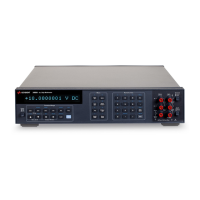
